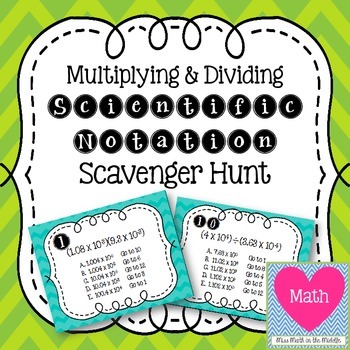Multiplying and Dividing Scientific Notation Scavenger Hunt
Miss Math in the Middle
170 Followers
Resource Type
Standards
CCSS8.EE.A.3
CCSS8.EE.A.4
Formats Included
- PDF
Pages
12 Scavenger Hunt Cards, 1 Answer Sheet, 1 Answer Key
Miss Math in the Middle
170 Followers
What educators are saying
My students always love these scavenger hunts, where they can check their answers as they go by seeing if they go back to a problem they have already been to.
Description
Get your students up and moving while practicing {{Multiplying and Dividing Scientific Notation}}. This scavenger hunt includes 12 problems: 6 multiplication problems and 6 division problems. Each problem is multiple choice. This activity works great for early finishers or as a whole class activity.
Directions:
1. Students start at any of the 12 cards and record the problem number and work on the Answer Sheet.
2. When finished, you can quickly and easily grade student work using the included Answer Key.
See my other Scientific Notation products:
Scientific Notation Scavenger Hunt
Directions:
1. Students start at any of the 12 cards and record the problem number and work on the Answer Sheet.
2. When finished, you can quickly and easily grade student work using the included Answer Key.
See my other Scientific Notation products:
Scientific Notation Scavenger Hunt
Total Pages
12 Scavenger Hunt Cards, 1 Answer Sheet, 1 Answer Key
Answer Key
Included
Teaching Duration
1 hour
Report this resource to TPT
Reported resources will be reviewed by our team. Report this resource to let us know if this resource violates TPT’s content guidelines.
Standards
to see state-specific standards (only available in the US).
CCSS8.EE.A.3
Use numbers expressed in the form of a single digit times an integer power of 10 to estimate very large or very small quantities, and to express how many times as much one is than the other. For example, estimate the population of the United States as 3 × 10⁸ and the population of the world as 7 × 10⁹, and determine that the world population is more than 20 times larger.
CCSS8.EE.A.4
Perform operations with numbers expressed in scientific notation, including problems where both decimal and scientific notation are used. Use scientific notation and choose units of appropriate size for measurements of very large or very small quantities (e.g., use millimeters per year for seafloor spreading). Interpret scientific notation that has been generated by technology.





